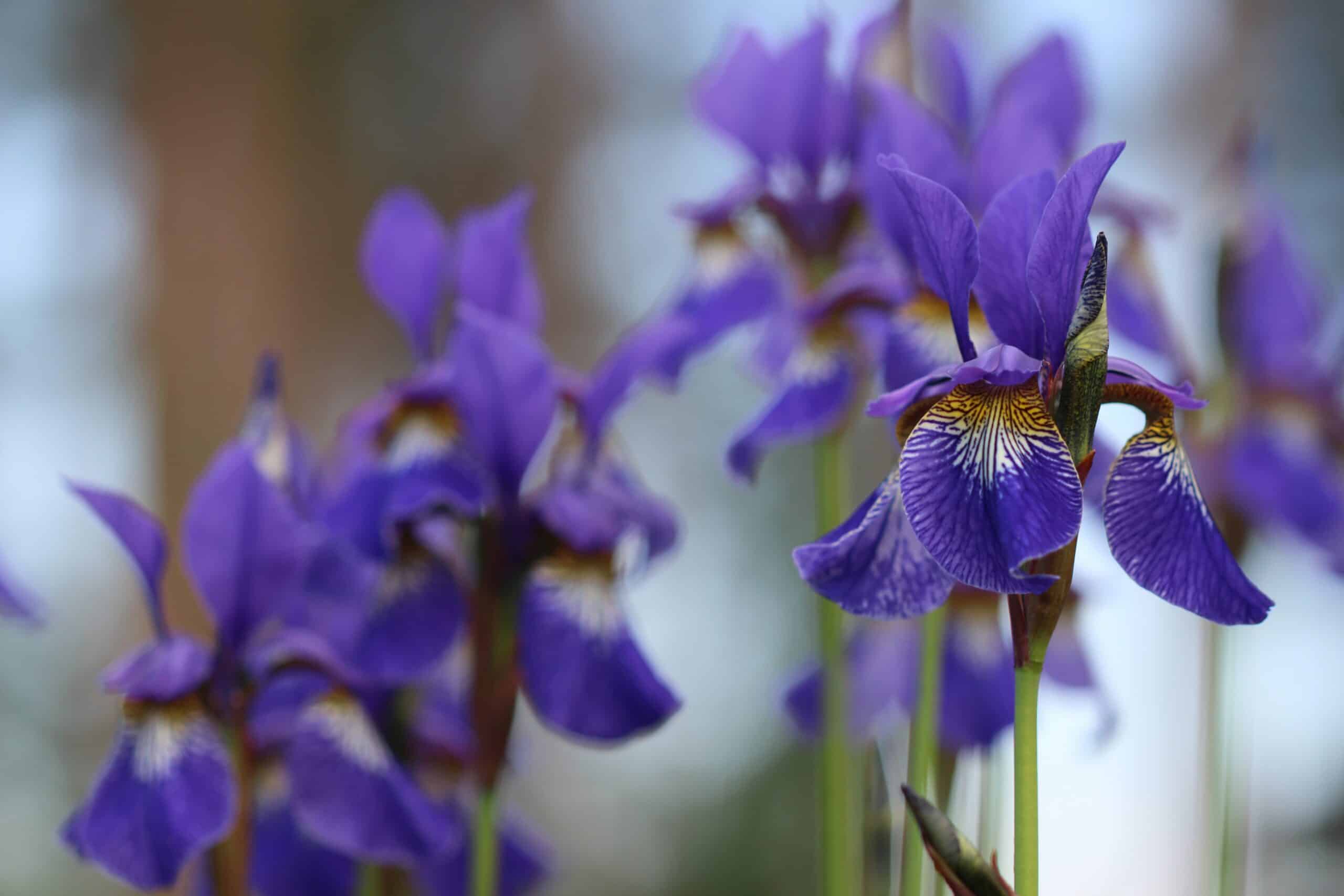Gardening is a great way to relax, connect with nature, and bring beauty into your home. According to the National Gardening Association, more than 80 million households in the United States participate in lawn and gardening activities. One of the most popular flowers for gardeners of all levels are Siberian irises. These beautiful blooms offer vibrant colors and long-lasting beauty that can be enjoyed throughout summer and beyond. In this article, you will learn how to grow and care for Siberian irises so they can thrive in your garden or landscape.
Siberian irises are perfect for beginner gardeners because they are low maintenance plants that don’t require any special skills or knowledge. They have upright growth habits with slender foliage and colorful blossoms that range from deep purples to pastel blues and whites. With their easy care requirements and stunning looks, it’s no wonder why so many gardeners choose them for their flower beds and borders.
Caring for Siberian iris is easy if you understand their requirements for water, sunlight, soil, temperature, and fertilizer. By providing the right environment for these plants you can ensure they will stay healthy and produce beautiful blooms year after year. Read on to find out everything you need to know about growing and caring for your Siberian iris!
Siberian Iris Overview
The stunning beauty of the Siberian iris is a sight to behold. With its deep, velvety petals and bright colors, it’s sure to add a touch of elegance to any garden. But not just any garden—growing and caring for these regal flowers requires some special attention. Here’s what you need to know about Siberian iris care.
Siberian irises are hardy perennials that grow in USDA Hardiness Zones 3-8, and they generally prefer full sun or partial shade. They’ll bloom from late spring through early summer, but their delicate flowers will need some special care to keep them looking their best. This includes providing adequate moisture during their growing season, as well as fertilizing regularly with a balanced fertilizer throughout the year.
When it comes to planting Siberian irises, the key is finding a location that has well-draining soil and enough space for them to spread out and thrive. Make sure the area gets plenty of sunlight throughout the day and is free from standing water after heavy rains or watering sessions—too much moisture can lead to root rot or other problems with your plants’ health. With a little bit of love and extra care, your Siberian irises will be blooming in no time!
Choosing A Planting Location
Ah, the age-old question: Where to plant your beloved Siberian Iris? It’s a decision with far-reaching implications. Do you plant it in full sun or partial shade? Near acid-loving shrubs or alkaline trees? The choices are daunting! But never fear; we’re here to help.
When selecting a location for your Siberian Iris, the most important factor is sunlight. It needs at least six hours of direct sunlight per day to thrive. If you live in an area with intense summer heat, however, you may want to provide some afternoon shade to protect your iris from burning. In addition, it’s important to choose an area with well-draining soil and adequate air circulation, as soggy soil can lead to root rot and other diseases.
Finally, make sure there is plenty of room around your Siberian Iris for it to spread out and reach its mature size of 2 to 3 feet tall and wide. You should also allow enough space between plants so that they don’t compete for resources such as water and nutrients. With the right location chosen, you’ll be well on your way towards healthy growth and beautiful blooms!
Preparing The Planting Area
Once you have identified a suitable location for your Siberian Iris, it’s time to prepare the planting area. This is a critical step in ensuring healthy, vibrant blooms. Here are the steps you should take:
First, clear away any weeds or debris from the space. If you have grass in the area, use a shovel to remove it and discard it. This will help to ensure that your irises get the light and nutrients they need without competition from other plants.
Next, till or dig up the soil. Use a garden fork or tiller to loosen it up so that your iris can easily take root. Remove any rocks and other obstructions from the area as well. You may also want to add some compost or topsoil to enrich the soil and add extra fertility for your flowers.
Finally, level out the soil by raking it into an even layer. This will help ensure that your flowers get plenty of water and sunlight so they can thrive in their new home. With these steps taken care of, your Siberian Iris are ready to be planted!
Planting Siberian Iris
Planting a Siberian Iris is easy and rewarding. It’s like learning to ride a bike: once you get the hang of it, you can make it look effortless. To start, you’ll need some basic gardening tools such as shovels, trowels, and pruners. You also need to prepare your planting area by loosening the soil and adding compost or manure.
Now that your area is ready for planting, it’s time to put the Siberian Iris in its new home. Start off by digging a hole that is twice as wide and deep as the root ball of your plant. Make sure to place the plant so the top of its root ball sits slightly above the ground level. Backfill with soil and lightly firm down around the base of the plant. Water well after planting and mulch around the base of your plant with organic matter such as wood chips or bark chips.
Finally, sit back and admire your work! Your Siberian Iris will soon be fully established in its new home and you can enjoy its stunning blooms every spring. With proper care and attention, this beautiful perennial can thrive in your garden season after season providing years of enjoyment for you and others.
Care Guide For Siberian Iris
Caring for Siberian iris is a rewarding experience, as these plants are known to be hardy and easy to maintain. To ensure they thrive in your garden, there are some important considerations to keep in mind. In this section, we’ll cover the basics of caring for Siberian iris so you can enjoy their beauty for years to come.
First, it’s important to provide adequate sunlight for your Siberian iris plants. They prefer full sun or partial shade, but will tolerate any amount of light as long as it’s not too intense. If you’re planting them in a shady spot, make sure there’s plenty of air circulation around the plants so they don’t become overcrowded.
Next up is soil preparation. The best soil for Siberian iris is well-draining and slightly acidic, with a pH level between 5.5 and 7.0. It should also be rich in organic matter like compost or peat moss to help retain moisture and nutrients. For best results, add a layer of mulch around the plants after planting to protect them from extreme temperatures and conserve moisture in the soil.
With proper care and maintenance, you can ensure that your Siberian iris will flourish year after year! Now that you know the basics of caring for these plants, it’s time to move on to another important topic – water requirements.
Water Requirements
When it comes to watering your Siberian iris, the biggest mistake you can make is overwatering them. The key is to keep the soil consistently moist without saturating it. You should water about once a week, unless there’s been an extended period of rainfall or drought. In that case, adjust your watering schedule accordingly.
When you do water the irises, make sure to water thoroughly and deeply at the base of each plant. This will encourage the roots to grow deep into the soil rather than staying near the surface where they are more susceptible to drying out. It’s also a good idea to mulch around the plants with compost or wood chips since this helps retain moisture in the soil and keeps weeds from growing as well.
Overall, proper watering is essential for healthy growth of your Siberian iris flowers. Too much or too little can lead to wilting blooms and even death of the plants if not taken care of properly. So be sure to monitor your plants carefully and adjust your watering routine according to their needs. And don’t forget about fertilizing – that’s just as important!
Fertilizing Requirements
“A stitch in time saves nine.” This age-old adage rings true when it comes to caring for your Siberian iris. Fertilizing the flowers regularly is a key factor in ensuring that they grow and blossom to their fullest potential. Here are a few simple tips to remember when fertilizing your plants:
- Apply a balanced, water-soluble fertilizer every month or two
- Check soil pH levels and adjust as necessary
- Don’t overfertilize, as this can burn the roots
- Make sure to water the soil after applying fertilizer
Fertilization should be done with care and attention if you want to get the most out of your Siberian iris. The best way to do this is by understanding the needs of your particular plant. Each type of plant requires different amounts of nutrients and fertilizers so it’s important to read up on what yours requires specifically. To ensure that your flowers grow healthy and strong, make sure that any fertilizer used is suited for them.
By following these simple steps, you can help keep your Siberian iris looking beautiful all season long. As an added bonus, fertilizing regularly will also stimulate blooming during the summer months. With proper care, you’ll soon find that these breathtaking flowers will become an essential part of your garden’s landscape! Now let’s move onto pruning and deadheading for optimum growth and appearance.
Pruning And Deadheading
Are you looking for the best ways to keep your Siberian Iris healthy and blooming? Pruning and deadheading are two important steps to ensure your flowers stay beautiful. Let’s explore what you need to do.
Pruning is a simple process that helps maintain the overall health of your Siberian Iris. It can help promote better flowering and reduce the risk of disease. Pruning should be done in early spring before growth begins. Remove any damaged, diseased, or dead foliage and stems, as well as any leaves that have faded from the previous season.
Deadheading is also essential for keeping your Siberian Iris looking its best. This involves cutting off spent flower heads after they start to fade, which will encourage re-bloom throughout the season and prevent seed formation, thereby preserving energy for new growth. To achieve this, use sharp pruners or scissors and cut back the stem just below where the bloom was located.
By taking these steps now, you can enjoy a stunning display of blooms in seasons to come! With proper care and pruning/deadheading techniques, you can control pests and diseases while ensuring gorgeous blooms all year round.
Controlling Pests And Diseases
Pests and diseases can be a major issue when growing Siberian iris. While they are generally hardy and not too prone to serious issues, there are some things to look out for. First, keep an eye out for slugs and snails that may attack the foliage. Second, watch for fungal diseases like rust or leaf spot. Finally, look for aphids and other insect pests that may feed on the leaves.
Fortunately, most of these problems can be controlled with careful monitoring and some simple steps. Keeping the area around the plants free of debris helps minimize the presence of pests. Additionally, avoid overhead watering if possible as this can increase disease pressure. In cases where disease is present, a fungicide may be necessary to control it.
If you take the time to pay attention to your Siberian iris plants, you’ll be able to keep them healthy and thriving throughout their growing season. From keeping an eye out for common pests and diseases to taking preventive measures when needed, controlling issues before they become a problem will help ensure your plants stay in great shape year after year. Moving forward with these tips in mind will make propagation techniques much easier!
Propagation Techniques
Planting and propagating Siberian irises is possible with the proper preparation and a few simple steps. Propagation techniques, when done correctly, can help you increase your garden’s beauty without breaking the bank. Here, we’ll discuss how to propagate these beautiful flowers.
Firstly, division is the most common method for propagating Siberian irises. You can divide clumps of rhizomes in late summer or early autumn. To do this, carefully dig around the clump and then use a sharp knife or spade to separate the individual rhizomes from each other. Afterward, replant them in a sunny spot with well-drained soil and then water them thoroughly.
Another way to propagate Siberian irises is by seed sowing. This method works best when started indoors in mid-winter to early spring while temperatures are still cool. Plant seeds in shallow pots filled with moistened seed compost and keep them at temperatures between 50-55°F (10-13°C). When new growth appears, transplant them into individual pots before planting outside after all danger of frost has passed.
TIP: Before planting or dividing any Siberian iris, it’s important to water your plants deeply so that they’re hydrated during the process! Proper hydration will help ensure successful propagation of your lovely blooms!
Dividing And Transplanting
Division and transplanting can be a powerful tool to propagate siberian iris. On average, each division yields three to five new plants. This makes it a great option for increasing the number of siberian iris in your garden quickly.
Before you divide, it is important to understand how long the clump has been in its current spot and how healthy it looks. Generally, siberian iris should be divided every three to four years as they spread quickly. If the clump is looking overcrowded or unhealthy, dividing sooner may be beneficial.
When ready to divide, start by digging up the entire clump with a shovel and carefully removing any excess soil from around the roots. Once you have separated the divisions, use sharp pruners or a knife to create clean cuts between them and make sure each division has at least one healthy fan of leaves attached before replanting them in well-drained soil.
Divide and transplanting siberian iris can help you increase your stock in no time while allowing you to revitalize existing plants that may need a fresh start elsewhere in your garden. With proper planning and care, you can enjoy these beautiful flowers for years to come!
Reusing Leftover Soil
It’s a wonderful coincidence that reusing leftover soil is the perfect way to make the most of your siberian iris. Not only does this method save money, but it also helps ensure that your irises will continue to thrive and grow for years to come.
When reusing leftover soil, the most important thing to remember is that you need to add in some fresh soil as well. This will help provide essential nutrients and minerals while also improving drainage if needed. Additionally, be sure to mix in some organic matter such as compost or peat moss, as this will help improve aeration and moisture retention.
The great thing about reusing leftover soil is that it can help reduce waste while still providing your siberian irises with everything they need for optimal growth. With just a few simple steps, you can have happy and healthy plants that will reward you with beautiful blooms all season long! Now that you know how to reuse leftover soil, it’s time to move on to long-term maintenance of your siberian irises.
Long-Term Maintenance
The next step in learning how to properly care for and grow your Siberian iris is understanding the importance of long-term maintenance. This can be a crucial part of keeping your plant healthy and vibrant for years to come.
When it comes to long-term maintenance, there are a few key steps you should take. The first is making sure that you’re regularly checking on and caring for your plants throughout the growing season. This includes watering, weeding, pruning and fertilizing as needed. Additionally, it’s important to routinely check on the soil health of your plants by testing pH levels and applying mulch if necessary.
Finally, when it comes to the longevity of your Siberian iris, it’s essential to remember that proper winter care is just as important as regular summer maintenance. This means protecting root systems from cold temperatures with layers of mulch or other forms of insulation during winter months. Taking these steps will ensure that your Siberian Iris will remain happy and healthy for many years! With this knowledge in hand, you’re ready to move on to companion planting with Siberian Iris.
Companion Planting With Siberian Iris
Companion planting with your Siberian iris is a great way to add texture and color to your garden. You can make the most of this tall, slender flower by pairing it with other plants that will compliment it, encourage growth, and bring in beneficial insects. Here are some tips for companion planting with a Siberian iris:
• Choose smaller plants that will not compete for light or water, like daylilies, columbines, or catmint. These varieties will also help attract pollinators to your garden. • Consider adding perennial grasses or ferns as an accent, which will provide texture and structure to the bed. • Use fragrant herbs like basil or mint near your Siberian iris to attract beneficial insects like bees and butterflies. • Select colors that complement each other to create a pleasing aesthetic. For instance, pair yellow and blue flowers together for a sunny effect!
With these companion planting tips in mind, you can easily create an attractive display of colors and textures around your Siberian iris. Be sure to take into account how much sunlight the different plants need so they don’t compete for resources or overcrowd each other in one spot. With some careful consideration when selecting companion plants for your Siberian iris, you can enjoy a beautiful garden all season long! Next up: troubleshooting tips to help keep your irises healthy and happy!
Troubleshooting Tips
Have you ever been frustrated while trying to grow Siberian iris in your garden? Don’t worry, as there are a few troubleshooting tips that can help make it easier. Let’s discuss 15. Troubleshooting Tips for growing and caring for Siberian iris.
The first step is to ensure the soil is well-draining and mulch is applied around the base of the plant. This will help keep moisture from building up around the roots and prevent root rot or fungal diseases from affecting your plants. You should also check the pH levels of your soil to make sure they are at a suitable level for Siberian iris to thrive. It’s best to use an organic fertilizer when feeding your plants, as this will provide them with all the nutrients they need to stay healthy and strong.
If your plants start showing signs of distress such as wilting, yellowing leaves, or stunted growth, you may have an infestation of pests such as slugs or aphids. These can be treated with natural methods like diatomaceous earth or neem oil spray, but if they become too severe you may need to consider chemical treatments. If your plants are affected by fungal diseases such as powdery mildew or rust, be sure to apply a fungicide immediately and prune off any affected leaves and stems right away so that it doesn’t spread further throughout your garden plot.
Finally, remember that patience is key when working with Siberian iris – this is a long-term investment so don’t expect overnight results! With proper care and attention you can enjoy beautiful flowers in no time at all!
Frequently Asked Questions
What Is The Best Time Of Year To Plant Siberian Iris?
Planting the perfect perennial for your garden is a process that requires planning and patience. Beautiful blooms of Siberian iris will reward you with their vibrant colors, but when is the best time to plant them? Alliterating advice on these majestic flowers will help you prepare for planting in the right season – springtime! Here are three tips to get you started:
Start by choosing a sunny spot in your garden. These flowers need at least six hours of sunlight each day to thrive.
Make sure the soil is well-drained. Before you begin planting, add compost or peat moss to improve drainage and aeration.
Finally, plant rhizomes in late spring after any danger of frost has passed. Planting at this time optimizes growth and helps ensure that your Siberian iris will bloom as expected.
It’s important to provide adequate water during the summer months as well. Water deeply once a week and more frequently during dry spells. Removing spent blooms can also promote healthy growth and prolong flowering from mid-spring through early summer. To maximize the beauty of your Siberian iris, divide large clumps every three or four years in early spring before new growth begins. By following these steps, you’ll have a thriving garden full of happy blooms ready for all to enjoy!
How Deep Should I Plant Siberian Iris Bulbs?
“It’s not often that you get something for nothing, but with siberian iris, you can. Planting bulbs of these beautiful blooms is a great way to reap the rewards of their beauty and fragrance. But how deep should you plant them? Let’s take a closer look.
As the old adage goes, ‘measure twice, cut once’. This applies to planting siberian iris bulbs too – it pays to make sure you’re planting them at the right depth. Generally speaking, they should be planted around four inches deep in well-draining soil. If your soil is heavy or clayey, then six inches deep is ideal.
When it comes to serving others, there’s no one size fits all answer when it comes to planting siberian iris. The main thing is to ensure that the bulbs are planted at the correct depth for your soil type – so make sure you measure carefully before planting! With a little know-how and care, these amazing flowers will reward you with their beauty and fragrance for years to come.
How Often Should I Water Siberian Iris?
One of the most beautiful and easy-to-care-for flowers in the garden is the Siberian Iris. This stunning flower’s beauty can transform any outdoor space into something truly breathtaking! But to keep your Siberian Iris healthy, you must know how often to water it.
Watering your Siberian Iris is essential for its growth, but it’s important not to overdo it. Drenching your irises once a week will provide all the moisture they need to thrive. Water them deeply and slowly so that the soil absorbs all of the liquid – no more, no less. If you don’t get this balance just right, your irises may suffer from too much or too little water, leading to potential problems with root rot and other diseases.
You may be wondering if there’s a way to make watering easier and more efficient – and there is! Investing in an irrigation system that waters your plants at specific times can save you time while ensuring that your irises get just enough moisture each week. With proper care and attention, your Siberian Irises will bloom beautifully year after year in glorious colors that never fail to amaze!
Should I Use Fertilizer On Siberian Iris?
The beauty of a Siberian Iris can easily be compared to the beauty of a butterfly. Its delicate petals and vibrant colors symbolize the power of nature and the potential for growth that lies within us all. If cared for properly, this flower will bloom more vibrantly than ever before – but what should you do to make sure it reaches its full potential? One of the most important things you need to consider is whether or not you should use fertilizer on your Siberian Iris.
Fertilizer can help improve soil quality and make sure your Iris has all the nutrients it needs to thrive. However, using too much or using it incorrectly can actually damage your plant, so it’s important to get familiar with how much and how often you should use it. In general, applying a balanced fertilizer once or twice a year is sufficient for most Siberian Irises, depending on their age and growing conditions. You may also need to supplement your fertilizer with occasional applications of other nutrients such as nitrogen or phosphorus if needed.
When applying fertilizer, make sure to avoid over-fertilizing your Iris by following the instructions on the label carefully. Additionally, be mindful of when and where you are fertilizing; avoid fertilizing during extreme weather conditions such as heavy rain or high temperatures as this could cause additional stress on your plant. Finally, always make sure to water thoroughly after fertilizing in order to prevent any root burn from occurring.
Caring for a Siberian Iris doesn’t have to be difficult – just remember that thoughtful attention is key! Proper watering, fertilization, and soil maintenance are necessary components for keeping these beautiful flowers healthy and happy throughout their lifetime.
How Do I Control Weeds Around My Siberian Iris?
Weeding around your siberian iris can be a daunting task, especially if you’re not sure where to start. But don’t worry – with the right knowledge and tools, you can keep weeds away from your precious flowers. So let’s dive in and find out how to control those pesky weeds!
Controlling weeds is essential when growing siberian iris. Weeds compete with the plants for nutrients and water, stealing the glory of your beautiful blooms. To fight back, take a proactive approach: use mulch and landscape fabric to prevent sunlight from reaching the soil surface, which helps suppress weed growth. Additionally, hand-weeding can help remove any existing weeds before they get out of control. As the saying goes, ‘a stitch in time saves nine’ – so don’t wait until it’s too late!
The best way to make sure that weeds don’t ruin your garden is by being vigilant. Regularly check for any new weeds that might have sprouted up and address them as soon as possible. It’s also important to take steps to keep your soil healthy – fertilizing and making sure that it has plenty of organic matter will help reduce weed growth in the long run. With a bit of dedication and effort, you’ll be well on your way to having a stunning siberian iris garden!
Conclusion
Satire is often used to draw in an audience and keep them engaged. It can also be used to make a point about an issue or topic. When it comes to Siberian Iris, the same rules apply.
Siberian iris are beautiful flowers that require special care and attention if you want them to look their best. If you follow the advice outlined in this article, your irises will be blooming in no time! But don’t let this deter you from planting these lovely flowers – with some effort and dedication, you can have a stunning garden of Siberian iris that will bring beauty to your home for years to come.
So what are you waiting for? Get out there and start planting! With the right care and attention, your Siberian irises will be flourishing before you know it. And who knows? You may even find yourself becoming the envy of your neighborhood with your vibrant garden of these gorgeous flowers!





























